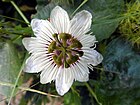Note: This is a project under development. The articles on this wiki are just being initiated and broadly incomplete. You can Help creating new pages.
Passiflora foetida
Passiflora foetida is a species of passion flower out of 550 species of Passiflora. It is native to the southwestern United States, Mexico, the Caribbean, Central America, Africa and much of South America. This plant is belongs to Passifloraceae family.[1]
Contents
[hide]- 1 Uses
- 2 Parts Used
- 3 Chemical Composition
- 4 Common names
- 5 Properties
- 6 Habit
- 7 Identification
- 8 List of Ayurvedic medicine in which the herb is used
- 9 Where to get the saplings
- 10 Mode of Propagation
- 11 How to plant/cultivate
- 12 Commonly seen growing in areas
- 13 Photo Gallery
- 14 References
- 15 External Links
Uses
Emmenagogue, Headache, Intestinal nematodes, Flatworms, Cold, Cough, Tuberculosis.
Parts Used
Chemical Composition
Phytochemicals such as carbohydrates, protein, fat, reducing sugar, ascorbic acid, flavonoids, alkaloid, phosphorous, magnesium, calcium, amino acid, cholesterol and phenolic compounds.[2]
Common names
| Language | Common name |
|---|---|
| Kannada | Kukkiballi |
| Hindi | Jhumka lata |
| Malayalam | Chirranchantiya, Poochapalam |
| Tamil | Siruppunaikkali, Chiru punai-k-kali |
| Telugu | Tellajumiki |
| Marathi | NA |
| Gujarathi | NA |
| Punjabi | NA |
| Kashmiri | NA |
| Sanskrit | |
| English | Love-in-a-mist, Stinking passionflower |
Properties
Reference: Dravya - Substance, Rasa - Taste, Guna - Qualities, Veerya - Potency, Vipaka - Post-digesion effect, Karma - Pharmacological activity, Prabhava - Therepeutics.
Dravya
Rasa
Guna
Veerya
Vipaka
Karma
Prabhava
Habit
Identification
Leaf
| Kind | Shape | Feature |
|---|---|---|
| Simple | Leaves are three- to five-lobed and viscid-hairy | When crushed, these leaves give off a pungent odor that some people consider unpleasant |
Flower
| Type | Size | Color and composition | Stamen | More information |
|---|---|---|---|---|
| Bisexual | Broadly ovate | White to pale cream | About 5–6 cm diameter |
Fruit
| Type | Size | Mass | Appearance | Seeds | More information |
|---|---|---|---|---|---|
| Simple Fruit | Ovoid | 2–3 cm diameter | Yellowish-orange to red | {{{6}}} |
Other features
List of Ayurvedic medicine in which the herb is used
Where to get the saplings
Mode of Propagation
How to plant/cultivate
Succeeds in warm temperate to tropical areas. Plants require a temperature no lower than around 16°c when they are flowering in order to ensure fruit set.[4]
Commonly seen growing in areas
Photo Gallery
References
- Jump up ↑ Karnataka Aushadhiya Sasyagalu By Dr.Maagadi R Gurudeva, Page no:93
- Jump up ↑ Chemical composition
- Jump up ↑ Kappatagudda - A Repertoire of Medicianal Plants of Gadag by Yashpal Kshirasagar and Sonal Vrishni, Page No. 294
- Jump up ↑ Cultivation Details
External Links
- Ayurvedic Herbs known to be helpful to treat Emmenagogue
- Ayurvedic Herbs known to be helpful to treat Headache
- Ayurvedic Herbs known to be helpful to treat Intestinal nematodes
- Ayurvedic Herbs known to be helpful to treat Flatworms
- Ayurvedic Herbs known to be helpful to treat Cold
- Ayurvedic Herbs known to be helpful to treat Cough
- Ayurvedic Herbs known to be helpful to treat Tuberculosis
- Herbs with Fruits used in medicine
- Herbs with Leaves used in medicine
- Herbs with common name in Kannada
- Herbs with common name in Hindi
- Herbs with common name in Malayalam
- Herbs with common name in Tamil
- Herbs with common name in Telugu
- Herbs with common name in English
- Habit - Herbs
- Index of Plants which can be propagated by Seeds
- Herbs that are commonly seen in the region of Lowland forest
- Herbs
- Passifloraceae





